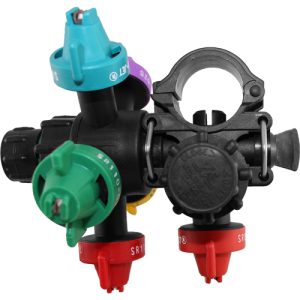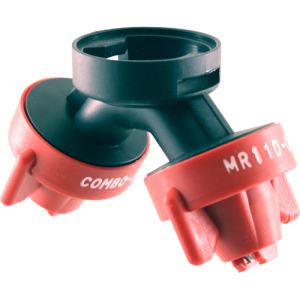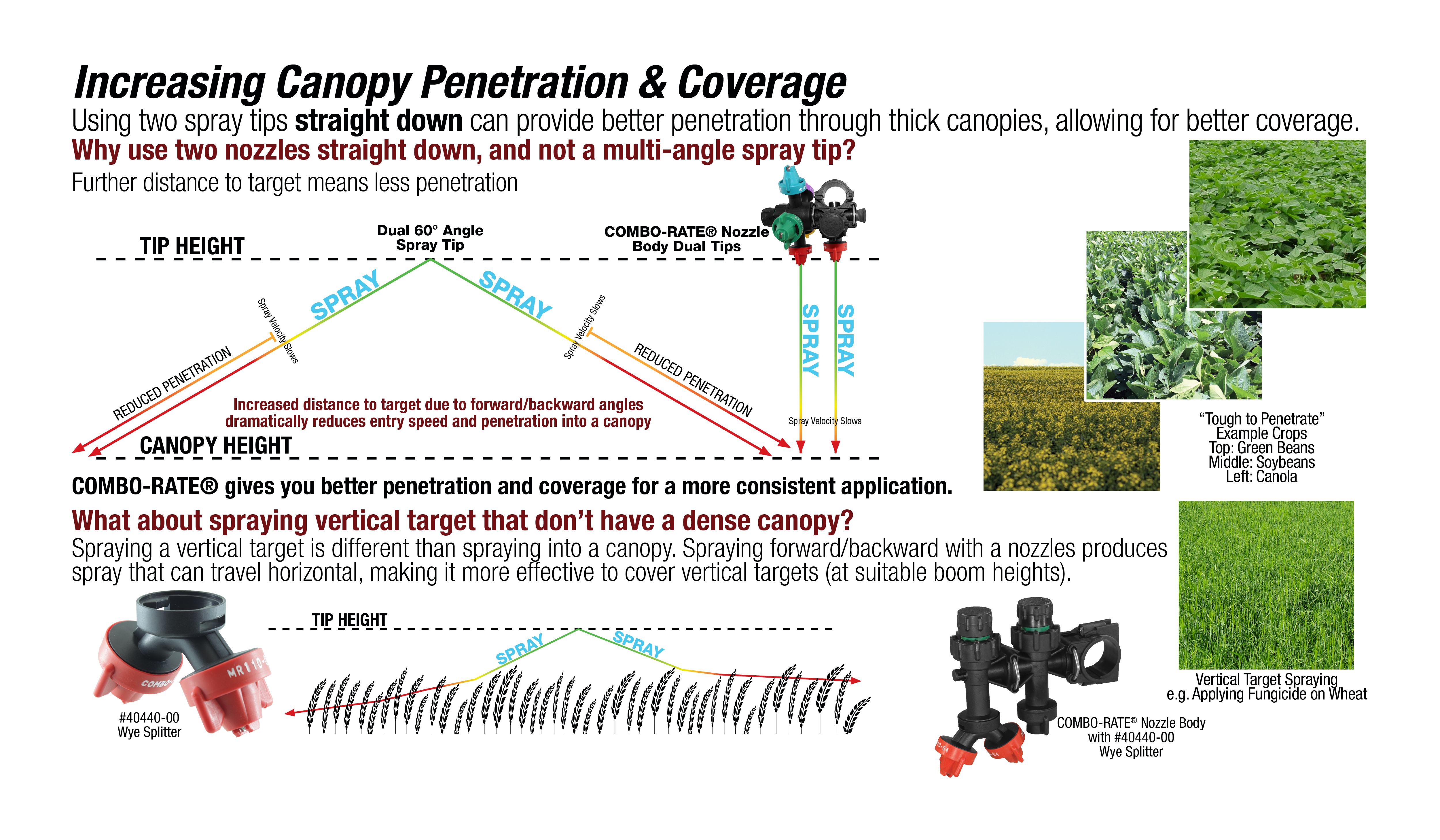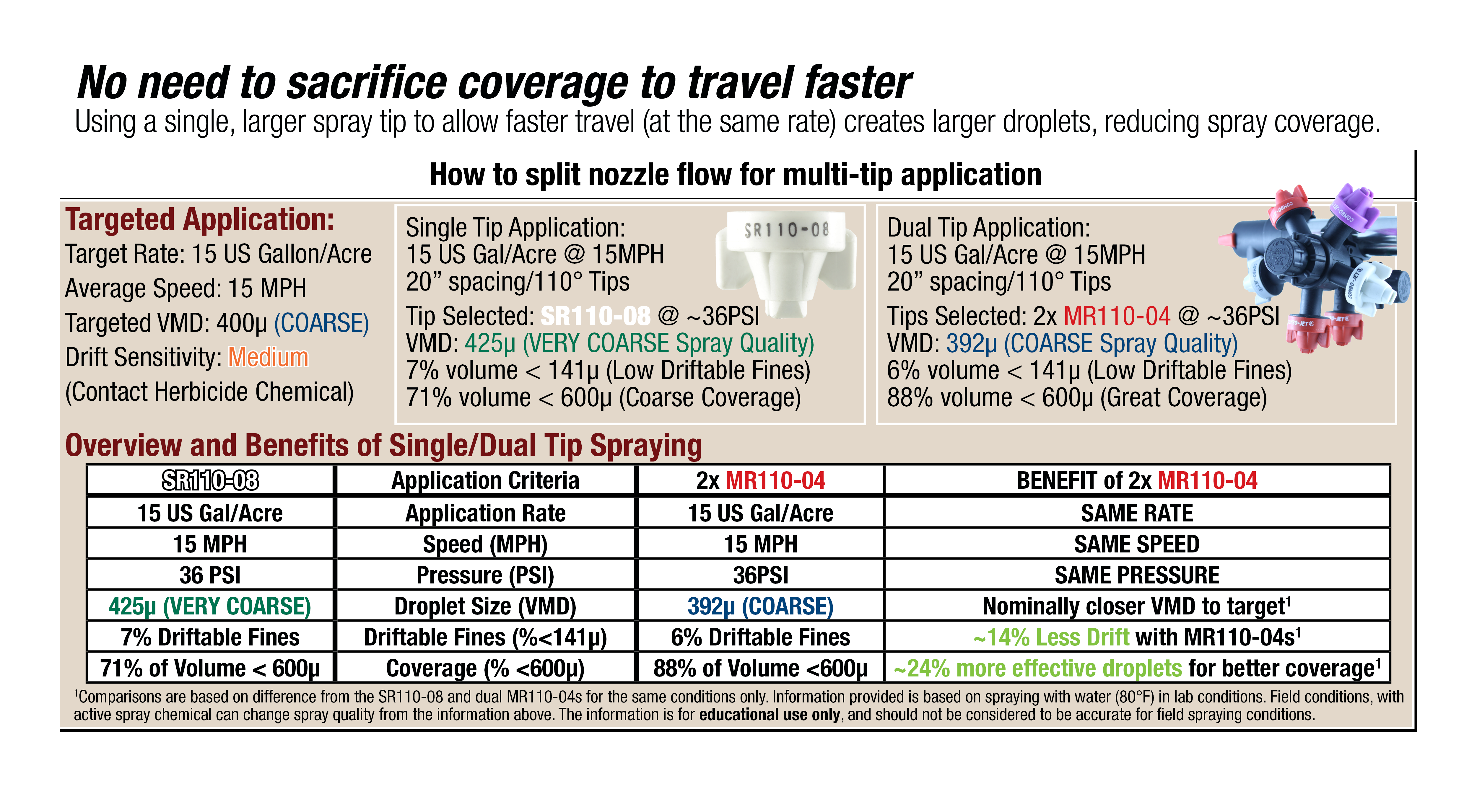“Spraying the foliage with a modern boom sprayer and tips is less like a two-dimensional painting process and more like dynamic droplet interception in which the foliage collects droplets that are moving past the foliage, beyond a simple droplet settling process.” -Dr. Al Womac
Targeted use of multi-tip & multi-angle spraying can provide huge gains in coverage, efficacy, and overall effectiveness of spray application, when used correctly.
It can provide significant gains in coverage, but when used improperly, can often increase risk of driftable fines, or providing less coverage. In the below information, it should provide an introduction and thought process that should be followed when considering spraying with multiple spray tips at the same time.

Multi-Tip [straight down] Spraying
In 2001, Wilger invented Combo-Rate® nozzle bodies, so that multi-tip spraying was possible. It effectively allows a user to stack modular nozzle bodies and turrets so they can use any combination of nozzles or spray tips to produce an effective spray application.
Multi-Tip spraying is typically accomplished by splitting up the total volume of intended spray (e.g. 10 US GPA) into parts (e.g. 5 US GPA + 5 US GPA) to produce controlled spray with more effective droplets.
On top of being apply to apply higher volumes of applications with more effective application (droplet sizes that are suited to get where they are meant to go, with correct dosage), the secondary goal of inventing Combo-Rate® was to be able to apply and switch between different rates or speeds without having to leave the cab. (Utilizing air-actuated nozzle bodies – stacked in sequence)
Read on to see some of the applications or conditions that make Multi-Tip spraying more effective.
Multi-Angle Spray Tips
Multi-Angle spraying is a newer spray technology being used for broadcast crop spraying. Out of a single nozzle outlet, spraying forward and backward at the same time to split up the total sprayed volume, when stacked nozzle bodies were not available.
Notably, most multi-angle spray tips do not employ methods of drift reduction within their design, so many multi-angle spray tips are the combination of two smaller (driftier) conventional flat fan spray tips, which are not typically recommended for many of today’s spray applications.
Wilger does not manufacture an integrated multi-angle spray tip, but it does produce a wye adapter (#40440-00), that allows any Combo-Jet® drift reduction spray tips to be used at the same time. This gains the benefit of being able to split up a high flow rate, but also gives control of the driftable fines produced.
Testing with use of a multi-angle spray tip shows that as they can provide better coverage for contact applications in nominal wind conditions, but in any adverse conditions, they can quickly be less effective.
There are some applications that overall do benefit from multi-angle spray tips. Read on for when to use multi-angle spray tips to significantly increase chemical efficacy.

What to watch out for while considering multi-angle spraying
Multi-angle tips, when used correctly, can make a whole world of difference in increasing spray efficacy. The trouble is, often, the spray technique is miss-used with less than opportune applications or chemicals.
As far as a resource in understanding some of the drawbacks and benefits of multi-angle spraying, as they relate to some targeted applications, read on:
Perks of Multi-Angle Spraying
As far as a few perks to consider when choosing to use multi-angle spray tips, find the following:
- [Increased front/back coverage on vertical targets]
- For some applications of fungicide or less drift-sensitive chemicals (e.g. spraying fusarium head blight (FHB) on wheat heads), having a horizontal spray can greatly improve coverage on the front and the back of a vertical target.
- Note: With minimizing off-target, ineffective spray, it is still recommended to adjust droplet size to improve the distance spray travels before slowing down. (coarser droplets travel further than finer droplets)
- [Makes small droplets high-flow applications]
- For very heavy volume applications (e.g. 30+ US Gallons/Acre), it allows two tips to produce much smaller droplets for finer coverage (than a single tip of the same flow), despite being on a forward/backward exit.
- [Versatility in splitting up flow]
- Gives the ability to split up the volume forward and backward for targeted applications that benefit from such variation. For adapters like Wilger’s wye adapter (#40440-00), it allows for two different tips & flow rates to be used, allowing versatility in choosing drift reduction tip series or flow rates.
Drawbacks of Multi-Angle Spraying
As far as a few drawbacks to consider when choosing to use multi-angle spray tips, find the following:
- Small Droplets do not travel far before they slow down [Increase in Driftable Fines]
- When splitting up a single volume into two volumes, the spray will be even finer and will not travel very far (sometimes <4″) before slowing down and succumbing to wind & sprayer speed. Much higher chance of the smaller droplets drifting.
- Angled tips increase distance to target. [Less Control & Accuracy]
- As multi-angle spray tips come in a variety of angles (e.g. 70°/30°, 60°/60°), they significantly increase the distance to target. This means the spray can have almost double the distance to travel, with the same amount of exit velocity from the tip. This makes spray a great deal harder to control and keep on target.
- This makes multi-angle tips more subject to environmental conditions like faster sprayer speeds or wind conditions that will influence drift & off-target spray.
- Despite some belief using multi-angle spray tips is as effective as multiple passes with a single tip, it is not the case.
- NOTE: Even for applications that can benefit from multi-angle spray tips in ideal conditions, it is still typically recommended to adjust the droplet size to be coarser, to offset the extra travel distance required.
- With further distance to target, canopy penetration is lessened [Less Canopy Penetration]
- With the exit angle increasing the distance to target – meaning slower speed upon entry into canopy – and less spray getting to target due to increased driftable fines, penetration into thicker canopy crops can suffer considerably. Often, coverage on the absolute top of the canopy may look great; however, as you progress down the canopy, coverage will suffer considerably.
- NOTE: By lowering the boom to lower heights to target, much of the effect can be lessened; however, with many travel speeds and field conditions, it is often unreasonable to do so.
What to watch out for when multi-tip (straight down) spraying
Multi-tip spraying is may look close to the same, but the results can be dramatically different. Multi-tip spraying (straight down) removes a lot the loss of control and increase in drift, making it a more stable application style across different modes of action, crops and targets.
As far as a resource in understanding some of the perks and drawbacks of multi-tip spraying, as they relate to some targeted applications, read on:
Perks of Multi-Tip (straight down) Spraying
As far as a few perks to consider when choosing to use multi-tip spraying (straight down), find the following:
- [Versatility in flow distribution for targeted coverage]
- A large benefit of splitting up the flow is being able to better distribute flow between the two (or more) spray tips. Being able to lead the spray swath with a coarser spray tip can actual lend itself to act as a curtain to lessen the environmental effects on the second tip(s).
- This spraying strategy has shown to be effective in studies trying to maximize coverage into canopies, as well as to control tough weeds like Palmer Amaranth.
- Since small droplets can penetrate through canopies (as the small droplets tend to be too light to displace the air on some of the top canopy leaves), a mix of coarse and fine droplets can act in synergy to cover different targeted areas of the crop. (e.g. coarser spray to reduce drift and target plant canopy, finer spray to penetrate into canopy and cover mid to low canopy).
- For one of the most recent studies on this style of spraying, find the ASABE article HERE.
- A large benefit of splitting up the flow is being able to better distribute flow between the two (or more) spray tips. Being able to lead the spray swath with a coarser spray tip can actual lend itself to act as a curtain to lessen the environmental effects on the second tip(s).
- [Makes small droplets high-flow applications]
- For very heavy volume applications (e.g. 30+ US Gallons/Acre), it allows two different tips to make overall smaller droplets (if required). Use of drift reduction spray tips is still recommended.
Drawbacks of Multi-Tip (straight down) Spraying
Using multi-tip spraying (straight down) alleviates many of the issues that might arise from using multi-angle spray tips, but consideration still must be taken for the effect of splitting up the flow of a spray tip:
- Small Droplets do not travel as far before they slow down [Increase in Driftable Fines]
- When splitting up a single volume into two spray patterns, the spray can be finer.
- This drawback can be alleviated by selecting proper drift reduction series spray tips to level off a good balance of coverage and drift.
Remember, this is just a beginner introduction to only some of the benefits/drawbacks of multi-tip and multi-angle spraying. As each field, crop, application is different, it should serve as a starting point for good considerations of which is best for the target you are trying to hit. (Whether it be a weed, disease, etc.)







